

Lido Finance has been extending its reach beyond Ethereum, significantly growing on Terra (aka. Lido on Terra), and the team behind it started developing Neutron in the Cosmos ecosystem after the Terra ecosystem collapsed.
Neutron, utilizing the Cosmos SDK and Cosmwasm, launched the Integrated Application Network, combining the benefits of smart contracts and appchain features for better automation and cross-chain interoperability.
Neutron incorporated "enshrined components" such as the CRON module for automation and the interchain components for enhanced cross-chain, embedded oracle module in the validators for reliable data retrieval, etc.
With a significant foundation laid, Neutron is poised for expansion by having new DeFi applications which are leveraging the enshrined components. The projects include Mars Protocol, Astroport, Amulet, etc.
Many know Neutron, a Cosmos smart contract platform, as the first chain to leverage restaked $ATOM for its block production. This restaking through the Cosmos Hub is called ICS (Interchain Security) and has been live in production since last year. However, ICS is just the tip of the iceberg when it comes to Neutron, and the team behind the project has gone through ups and downs, including being a contributor to Lido’s expansion plan, building what was once crypto’s largest liquid staking project, Lido on Terra. Now, they are building crypto’s first “Integrated Application Network,” imbuing smart contracts with the powers of appchains to enable entrepreneurs to build better and more profitable applications that can onboard users from anywhere. Let’s walk through how the team started Neutron and how what they’re building enables new breakthrough DeFi applications.
Lido Finance, the leading project in the Ethereum liquid staking sector, has been dynamically extending its reach beyond Ethereum. With this expansion plan, Lido's operations spanned to other Layer 1 blockchains like Solana, as well as Layer 2 blockchains like Polygon, Arbitrum, and Optimism. Lido's expansion strategy comprised two primary approaches. Firstly, it deployed its codebase on additional ecosystems such as Terra and Solana. Secondly, it partnered with bridge providers to facilitate transfers of its tokens—wstETH and stETH—to other blockchains like BNB chain and Linea.
Under the banner of "Lido on X", the initiative started to leverage Lido's brand value and experience to broaden its foothold within the liquid staking sector. While most attempts did not yield anywhere near as much value as Lido’s operations on Ethereum, the Lido on Terra initiative stood out, once surpassing the Total Value Locked (TVL) of Lido on Ethereum.

P2P, one of the companies leading Lido’s expansion, built Lido on Terra. As Lido on Ethereum issues stETH for staked ETH, Lido on Terra issued bLUNA for staked LUNA. LUNA staking rewards were allocated to bLUNA holders, and as the Terra ecosystem grew, the TVL of Lido on Terra increased at a rapid pace, once surpassing the TVL in Ethereum, becoming the largest liquid staking project in the crypto industry. The development was led by developers in P2P, and they were able to build and operate the project in the non-EVM, CosmWasm environment. However, with the collapse of UST and LUNA, Lido on Terra fell, and after a long consideration, it sunset its operations on Terra.
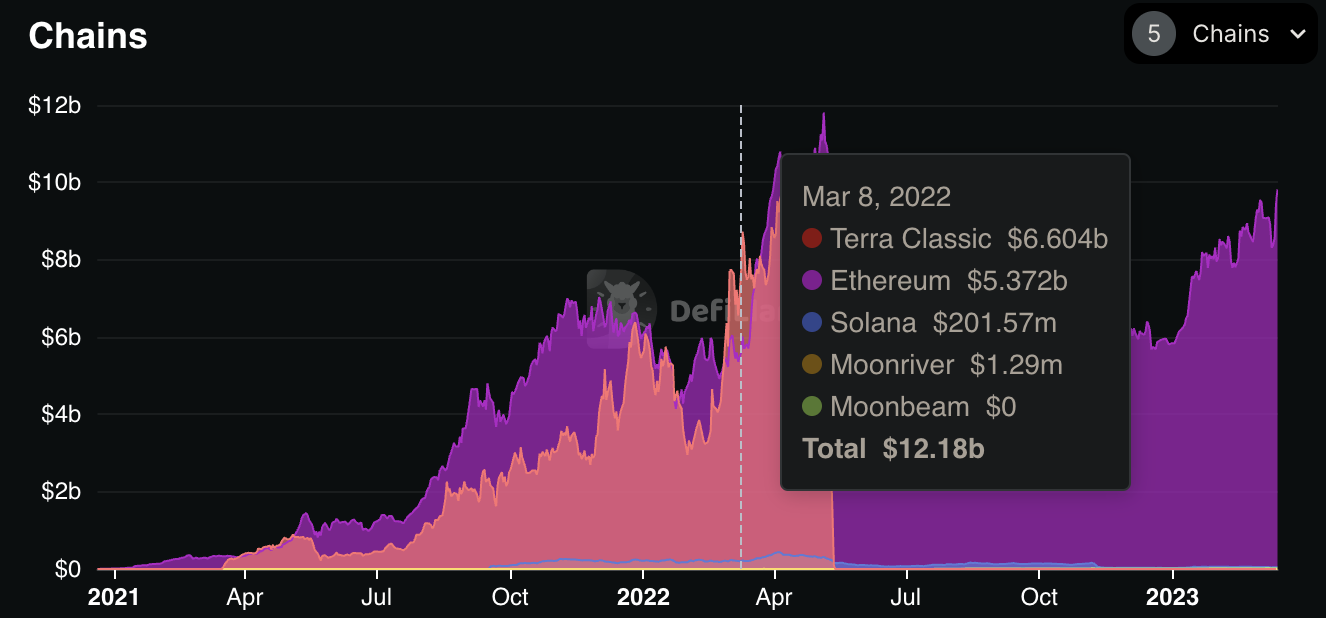
Source: TVL of Lido- DefiLlama
As the developers at P2P had strong experience in building and operating one of crypto’s largest DeFi projects, they started looking for a new opportunity to build their next project. Ultimately, they thought about what they could build within the Cosmos ecosystem. As they saw a need for a smart contract platform purpose-built for DeFi projects, they started working on Neutron. From the beginning, they wanted to create a platform that was built to last, so they decided to leverage over $2.5B in economic security from the Cosmos Hub via ICS. They also bring wstETH over from Lido on Ethereum via Axelar to enable users on Neutron to earn Ethereum staking rewards while taking advantage of DeFi opportunities within the ecosystem.
These developments helped lay the chain’s foundation, and in December 2023, they announced their ambitious plans to enable “Integrated Applications” on Neutron.

Source: Introducing Neutron, Tweet

Neutron is a smart contract blockchain platform built using the Cosmos SDK and CometBFT, with CosmWasm as the smart contract development framework at its core. It is the first chain to align with the Cosmos community and leverage ICS via the Cosmos Hub to enable economic security. Unlike most chains that are forced to emit millions of dollars in their token supply to incentivize users and validators to secure their network— which leads to forced sell pressure on the underlying token—Neutron’s usage of ICS enables it to maintain robust economic security for its ecosystem of builders and users while avoiding the creation of unnecessary inflationary sell pressure on its token, $NTRN. This also means that the Neutron community has a greater quantity of tokens it can use for ecosystem grants and other economic growth efforts.
On top of this, it has built crypto’s first Integrated Application Network—a powerful platform that enables developers to deploy apps with the speed and composability of smart contracts without trading off the powers that appchain can provide, such as native automation, arbitrary cross-chain interoperability, MEV recapture, custom fees and mempools, and more. Neutron's unique architecture blends the best features from both appchains and smart contracts to enable the creation of breakthrough DeFi applications. Let’s see some of the things that can be built on the Integrated Application Network.

Source: Neutron : The Integrated Application Network
Unlike typical smart contracts that are limited by the specific virtual machines they operate on, Integrated Apps on Neutron can access components that exist outside of the VM they operate on. This interaction includes elements like transaction fee mechanisms, consensus votes, and interchain transactions. This allows dApps on Neutron to function more efficiently and securely, bypassing the restrictive barriers of conventional smart contract environments.
Furthermore, Neutron introduces enhanced automation and operational efficiency through its CRON module, which provides permissioned smart contracts with end-of-block computation capabilities. This functionality is vital for applications that need to perform regular maintenance activities like updates or rebalances autonomously, which is common in platforms such as yield aggregators or decentralized exchanges.
In terms of connectivity, the Neutron network is designed to support high levels of cross-chain interoperability. Through features such as its in-house-designed Interchain Transactions (ICTX) module and Interchain Queries (ICQ), Integrated Apps on Neutron can register accounts, manage assets, and execute contracts remotely across any connected IBC blockchain. This capability not only enhances the fluidity and functional reach of Neutron apps but also maintains robust security measures. ICQ further allows these applications to integrate and query data from multiple blockchains, streamlining operations and reducing the complexity and overhead typically associated with such processes.
Addressing common barriers in blockchain technology, Neutron also focuses on better user onboarding and scalability. The network allows Integrated Applications to customize Neutron blockspace per user requirements, such as creating gas-free lanes for newcomers. This approach helps lower entry barriers and promotes wider adoption by making it easier for new users to join the platform.
Lastly, Neutron places a high emphasis on security and reduces development risks associated with blockchain applications. By incorporating oracle data feeds and operational features directly into its protocol, Neutron minimizes the reliance on third-party service providers, which are often susceptible to attacks. This integrated security framework helps protect applications against risks like data manipulation and delays, enhancing overall safety and reliability for developers and users alike.
Neutron integrates several specialized features and modules that are "enshrined" in the chain itself. This provides a comprehensive framework that enhances the capabilities of smart contracts, making them more powerful and efficient. Here's a list of the enshrined components in Neutron.

3.1.1 CRON Module
The CRON module in the Neutron blockchain serves as an essential tool for enabling the automation of critical tasks within applications. It allows for the registration of schedules, with names acting as keys, thereby facilitating permissioned smart contract hooks for end-of-block computation. This feature can be essential for DeFi protocols that need to perform timely operations like rebalancing or capital offloading.
3.1.2 Duality
Duality was a separate DEX blockchain in the past but has integrated into Neutron as an in-protocol order book that enhances the trading functionalities of dApps on Neutron. Duality is a hybrid exchange that offers advanced order book capabilities and a variety of order types. It aggregates liquidity from both automated market makers (AMMs) and traditional order flows, combining them into a hybrid DEX.
3.1.3 The Block SDK
The Block SDK is a toolkit designed to provide a comprehensive set of primitives tailored for the Cosmos SDK and ABCI++. These resources are invaluable for blockchain projects, as they allow for the customization of Neutron’s blockspace and mempool to cater to specific use cases. This component can segment blockspace to prioritize transactions and accommodate gas-free lanes for easier user onboarding.
It can also enable developers to customize the validation mechanisms within the blockchain. This includes defining and implementing custom validation logic for transactions, ensuring that only valid and authorized transactions are accepted and processed.
3.1.4 Oracle Module - Slinky
It is designed to bring oracle updates directly in-protocol, guaranteeing data feed execution at reduced latencies and increased reliability. This module helps prevent manipulation and ensures that DeFi protocols operate on the most accurate and timely information. This has been developed by Skip protocol, which has also developed the Block SDK.
IBC is a core part of Neutron's architecture, enabling seamless connectivity with other cosmos blockchains. Neutron has been incorporating the latest advancements in IBC and building some of its own. Below is a list of some functionalities that Neutron provides with IBC.
Interchain Transactions (ICTX): Enables smart contracts to interact with remote blockchains securely and efficiently, controlling accounts, deploying contracts, and managing transactions across networks without the usual need for trust-heavy mechanisms like multisig setups.
Interchain Queries (ICQ): Facilitates applications querying state and transaction histories from any Inter-Blockchain Communication (IBC) connected blockchain, thus vastly reducing overhead and boosting cross-chain operational capabilities.
Packet-Forward Middleware: Allows Integrated Apps to automatically forward tokens to another chain by triggering another IBC transfer. This enables moving tokens between any two chains even if a direct IBC connection does not exist between them.
IBC Hooks: A module in the Neutron blockchain that allows token transfers over IBC to trigger contract calls. This enables applications on other chains to easily integrate with Neutron and leverage its functionality. It allows token transfers over the IBC protocol to trigger smart contract calls on Neutron, for instance, cross-chain zaps.
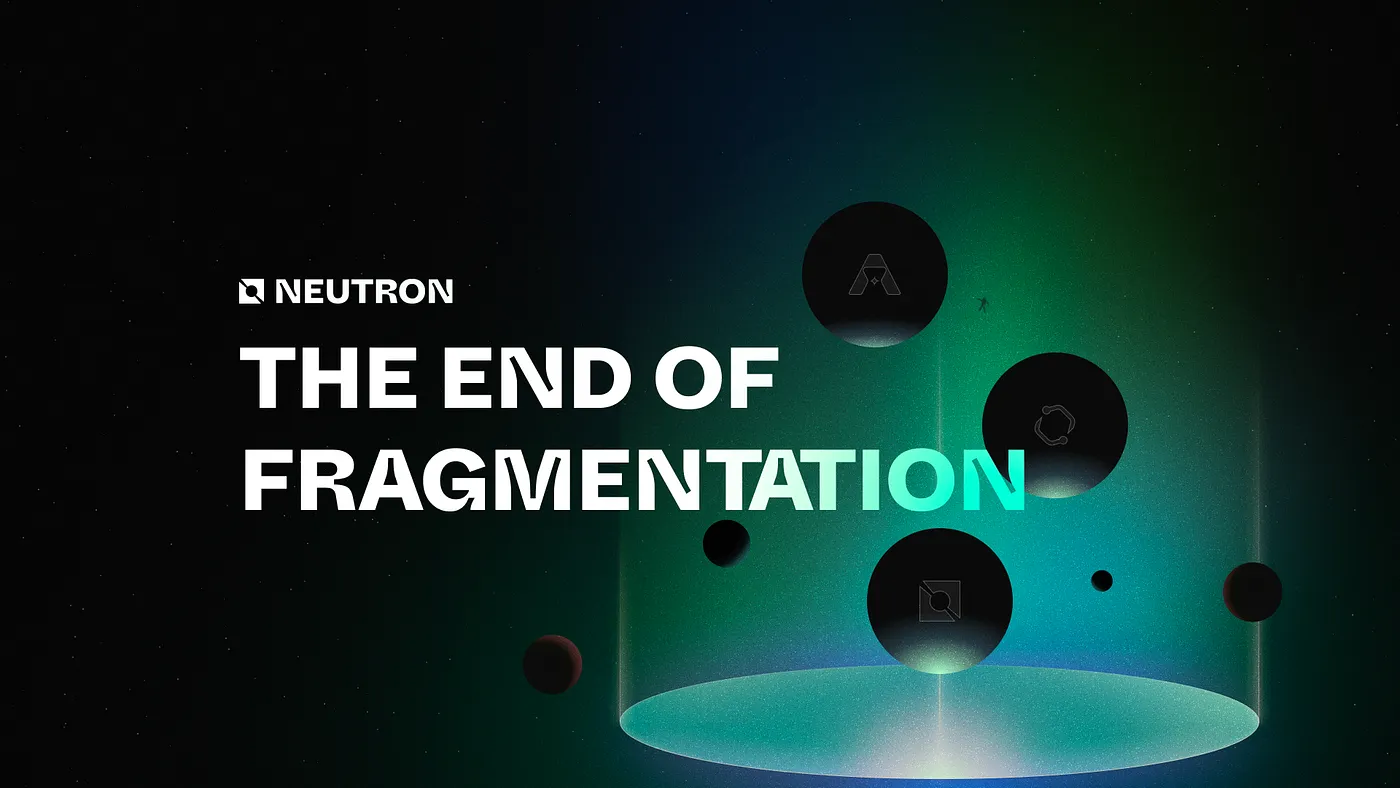
Source: The End of Fragmentation. How Neutron, Astroport and Duality
Astroport—a decentralized and open-source AMM operating on the Neutron, Osmosis, Terra, Injective, and Sei blockchains, enabling non-custodial liquidity and price discovery for any crypto asset—is set to leverage Duality to handle liquidity across various market scenarios. This strategic use of Neutron's Duality involves several approaches to liquidity distribution and management. Here’s a breakdown of how Astroport plans to utilize Duality:
4.1.1 Integration with Duality’s Advanced Market Primitives
Duality's infrastructure enables complex market-making and liquidity management strategies by allowing creators to emulate almost any strategy from traditional financial markets, from expiring limit orders to AMM-like range orders. These advanced features are especially beneficial to sophisticated market makers, who can now use smart contracts to transcribe intricate strategies that were previously centralized.
Duality also enables diverse liquidity management where typical Liquidity in AMMs are continuous. Duality manages this liquidity using distinct bins (or ticks). Two strategies—equal height and equal width—are considered when transforming continuous liquidity in Astroport’s pools into discrete chunks suitable for Duality’s framework.
“Astroport’s many pool types are the perfect complement to Duality’s liquidity primitives. Their logic can be encoded into vaults that simplify liquidity management and can be incentivized by protocols. In particular, Astroport’s specific pools for LSTs, weighted pools, and concentrated liquidity strategies can be compiled and run on top of Duality, without recreating complicated trading logic each time. This combines the best of both worlds: aggregating liquidity from sophisticated, active market-makers as well as decentralised, passive strategies into a single venue.” - From **The End of Fragmentation. How Neutron, Astroport and Duality
This implementation can essentially protect Neutron from liquidity fragmentation, reduce dependency on complex order routing, and magnify the liquidity efficiency delivered to all participants, including LPs and traders.
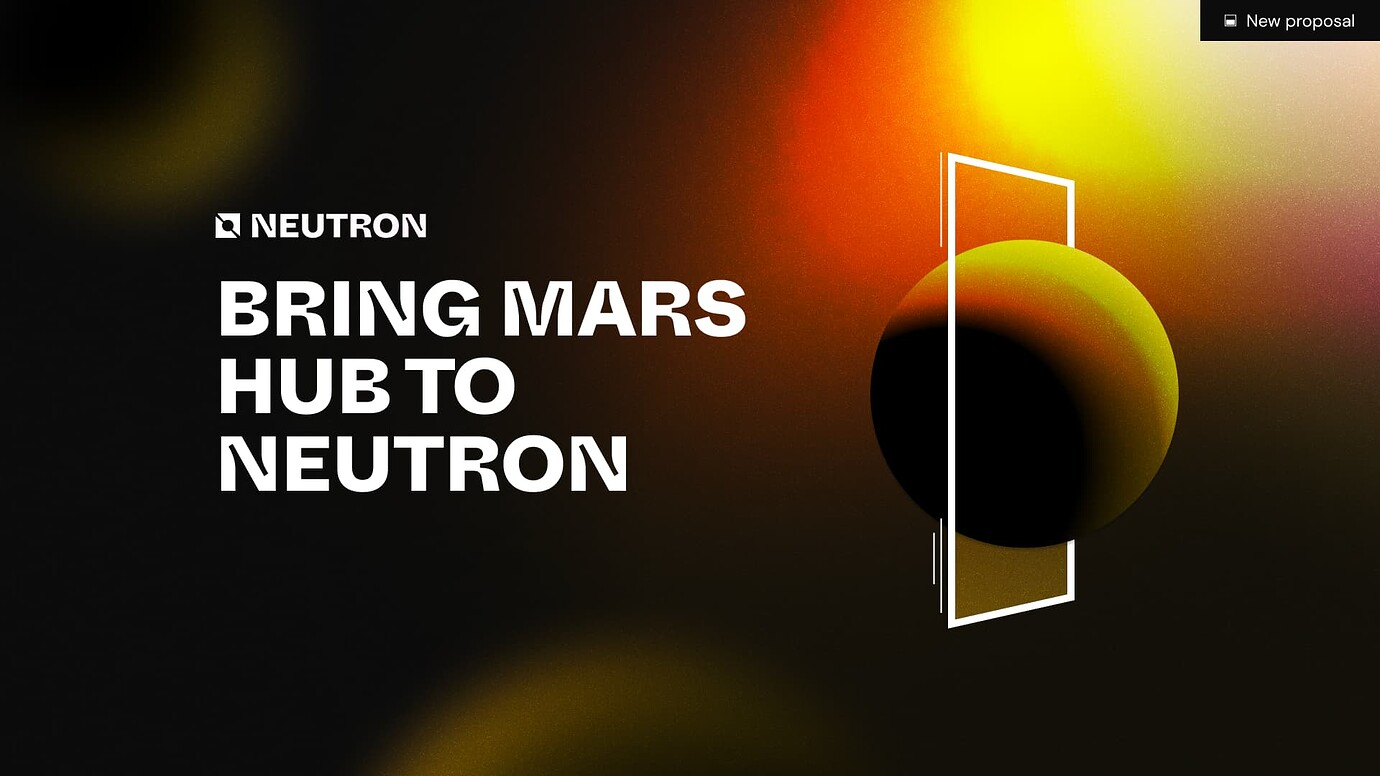
Source: [PROPOSAL #26] Make Neutron the home of Mars Protocol
Mars Protocol—an advanced DeFi appchain supporting borrowing, lending, spot trading, leveraged staking, and leveraged farming—has decided to migrate from being its own Cosmos appchain to being an integrated DeFi super-app on Neutron following a mutually voted-on proposal on the Mars and Neutron governance forums. Mars plans to strategically leverage the capability of contract pinning for Oracles within Neutron for the performance of its blockchain transactions. This integration would also optimize operational capabilities in significant ways.
4.2.1 Contract Pinning of Oracle Contracts
The cornerstone of this approach lies in the pinning of contracts directly to the memory on validator nodes. By keeping frequently utilized contract binaries, such as those from Mars Oracle, constantly loaded in memory, the protocol ensures faster transaction execution. This method eliminates the necessity of reloading contracts from the disk with each transaction execution, thereby reducing the computational overhead. For Mars, this translates into substantially lower gas consumption, a critical factor in enhancing overall performance. This absence of disk fetch times speeds up the process considerably, providing Mars with a competitive edge in the DeFi space, where transaction speed can critically impact trading strategies and outcomes. However, it requires more memory usage.
Pinning contracts also heightens reliability by minimizing delays associated with disk I/O operations. This aspect is particularly vital during periods of high network activity, where consistent performance is crucial for user satisfaction and trust in the Mars Protocol.
4.2.2 Customization of Fee Module
Mars Protocol takes full advantage of Neutron's globalfee module, which allows for the adjustment of critical network-level parameters like gas costs. This capability, combined with contract pinning, results in not only faster but cheaper transactions, which can be beneficial during times of high network congestion. Moreover, enhanced validator incentives emerge as a natural consequence. With reduced gas costs and swifter transactions, validators experience higher transaction throughput. This increase potentially boosts their fee collection, balancing out the increased resource usage with enhanced earnings.
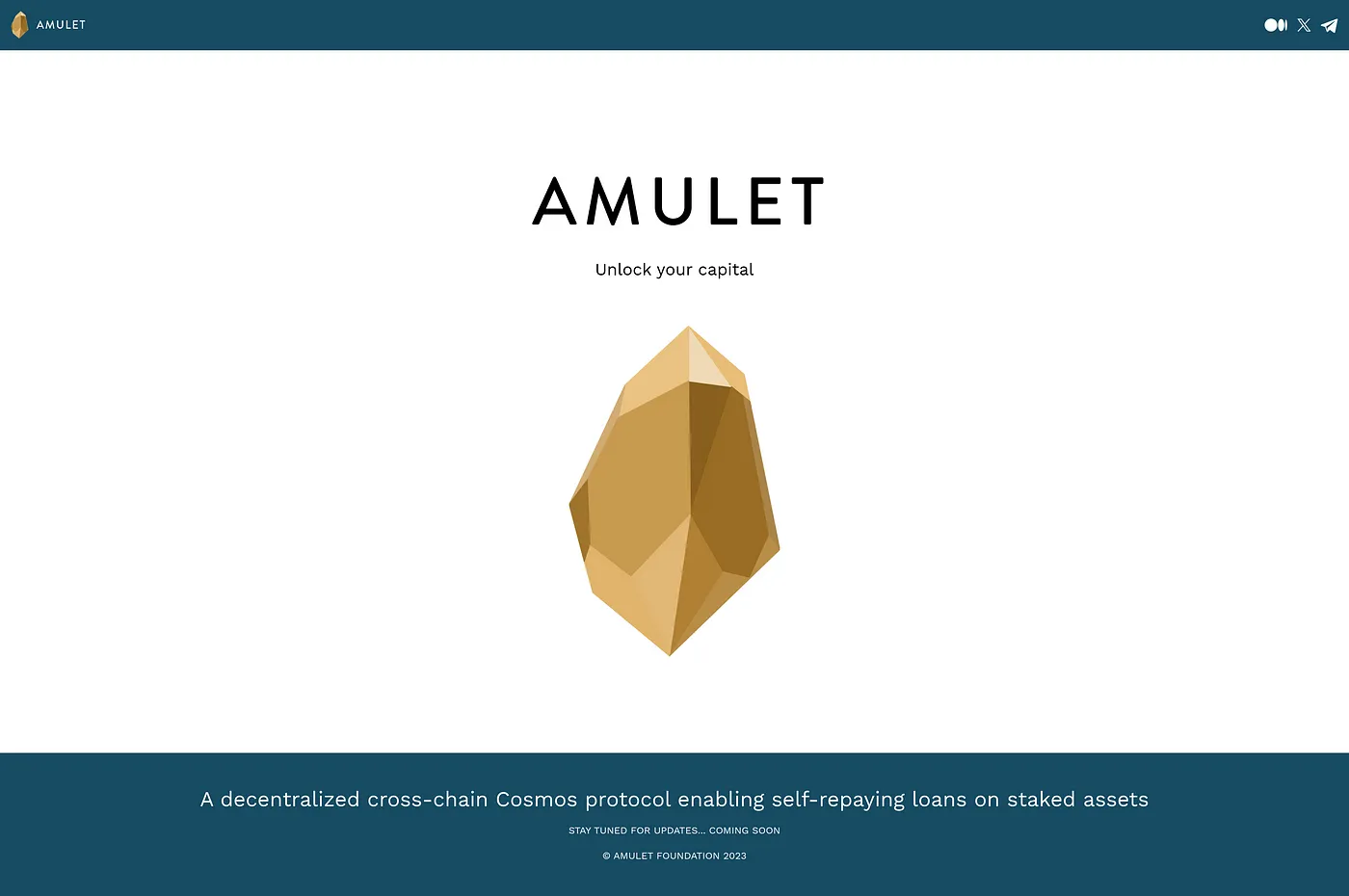
Source: Introducing Amulet — Unlocking DeFi on Cosmos
Amulet Finance, now live on Neutron’s testnet, introduces self-repaying loans aimed at leveraging staked cryptocurrency assets. It utilizes Neutron’s cross-chain interoperability features to enable seamless interaction with other Cosmos blockchains.
4.3.1 ICA (Interchain Account)
Interchain Accounts enable blockchain networks to perform actions on other chains on behalf of users or other chains, which is useful for conducting operations across different blockchain ecosystems without requiring users to manually manage cross-chain transfers or multiple wallets. Amulet Finance leverages this feature for enhanced user convenience through the automation of asset management, including staking, unstaking, and collateral management—all directly from their app on Neutron. Furthermore, the use of ICA could bolster security by minimizing the risks associated with sharing private keys and manually conducting transactions on various chains.
4.3.2 ICQ (Interchain Query)
In parallel, Interchain Queries facilitate the secure retrieval of data from other chains, essential for operations dependent on external data. For Amulet, this means having access to real-time data on the performance of staked assets or the current status of different collateral types across chains. This capability could allow for dynamic adjustments to loan terms or collateral requirements based on up-to-date market conditions or performance indicators.
By utilizing Neutron’s cross-chain capabilities, Amulet can streamline the management of collateral through automatic staking and ongoing management, thus facilitating a model where loans repay themselves over time. ICA could enable Amulet's smart contracts to execute or adjust terms automatically based on this data from ICQ, such as using yield from staked assets to repay loans if certain thresholds are exceeded. Such use of blockchain interoperability can simplify UX and enhance the economic efficiency of using digital assets as collateral.
The team behind Neutron has significant experience building one of crypto’s largest DeFi protocols, Lido on Terra. With the launch of their "Integration Application Network," they have introduced and will continue introducing many important primitives to the industry. Below, we outline two key aspects readers should focus on regarding their future footprint. Also, as Neutron is one of the first projects to leverage restaking in production, a detailed explanation of their economics is also included in the APPENDIX.
There has been a surge of new rollups being launched in the Ethereum ecosystem. A rollup’s goal is to leverage its own execution environment to tailor the infrastructure for an application and capture the economic value within the rollup. As I discussed in my previous article, "Blueprint of DeFi Rollups," there are ongoing experiments on how they are being customized for specific use cases. In this regard, the Cosmos Ecosystem, especially Neutron, offers valuable insights. Neutron has features embedded in its infrastructure that provide optimal DeFi support. Rollups could certainly learn from Neutron's approach.

Neutron is entering a new phase of growth, with numerous integrated DeFi apps expected to launch soon. Projects such as Astroport and Mars have successfully constructed their infrastructure and attracted user interest. It will be interesting to see what DeFi apps get built on the Neutron platform in the coming months. As I had a conversation with the team, I know big things are coming.

Neutron is one of the first blockchain to rely on other blockchain for its block construction. The whole set of validators in Cosmos Hub work as the validators for Neutron. This concept is known as ICS (Interchain Security) which has been in long research and development. ICS has three stage where for v1, the whole set of validators participate, for v2 (current stage), a subset of validators participate, and for v3, other Cosmos blockchains other than Cosmos Hub will be able to act as validators for other chains. This is benefitial to both entities because for the security consumer chain, they can reduce the cost of operating own validator sets and the security provider chain can accrue more values to their token, in this case $ATOM.
This concept is similar to how “Restaking” works in EigenLayer, where staked $ETH is used to validate other services, known as AVS (Actively Validated Services). The so called operators validate the service of AVS and if there were malicious activity, the staked $ETH is slahsed. Recently, the first AVS, EigenDA launched in the Ethereum mainnet. However, without any slashing and incentive mechanism. This was done so as a protective measure, however, public discussion on the structure of this economics is not done a lot. So there will be lessons for EigenLayer to take away as Neutron has been operating as the $ATOM restaked AVS. In this section, lets look into how the economics of Neutron works, and what takeaways are there for EigenLayer.
The economics of Neutron, particularly related to the ICS concept from the Cosmos Hub, includes a mechanism that incorporates transaction fees and governance models. This mechanism enhances the platform's security and operability. The Cosmos Hub takes an "optimistic" approach to slashing, where the community has the ability to slash validators once a "slash packet" is sent, regardless of the validators' intent.
A.1.1 Incentive: Transaction Fees and ICS

ICS in Neutron has an economic mechanism where part of the transaction fees collected on the Neutron platform is allocated to support the broader security of the Cosmos Hub. This means that when transactions occur within Neutron’s ecosystem, a portion of the fees generated goes beyond merely compensating validators or covering operational costs within Neutron itself.
Transaction Fee and MEV fees Collection: On Neutron, executing transactions incurs small fees to protect the platform from spam and for its services such as their smart contract dapps or Interchain Queries, and IBC communication. Also since the captured MEV will also be shared.
Fee Distribution: Part of these collected fees (specifically 25% of them) is directed to the Cosmos Hub as a form "Interchain Security (ICS) payment". After making the Interchain Security payment, the residual NTRN tokens are burnt, which helps in deflationary pressure on the NTRN supply, possibly increasing the token’s value over time. Other denominations from fees can be sent to the Neutron DAO's Reserve.
This 'ICS' payment underscores an economic relationship where Neutron leverages the security and value of the Cosmos Hub, benefiting from the hub’s large staked assets and infrastructure.
A.2.2 Slashing
In the context of the Neutron blockchain, "slashing" is a punitive mechanism applied to Cosmos Hub validators who fail to adhere to the network's operational standards. Slashing conditions in the usual Cosmos blockchains are primarily triggered by actions that compromise the network's security or operational efficiency. These actions include double-signing, where a validator signs two different blocks at the same height within a single chain, or downtime, where a validator is offline and not participating in the consensus process for an extended period.
In the specific case of Neutron, which utilizes Interchain Security additional complexities arise. For instance, during a rolling upgrade of Neutron, validators are expected to upgrade to the latest version of the node software. However, discrepancies can occur when two validators reportedly "double-signed" during this process, leading to a proposal to slash these validators. This incident occurred and it highlights the sensitivity of the slashing mechanism to operational errors, even if they are accidental.
The process of slashing in Neutron's Interchain Security involves several steps:
Detection of Misbehavior: The first step is the detection of a validator's misbehavior, such as double-signing or significant downtime. This can be automatically detected by the network or reported by other participants.
Submission of Slash Packet: If a validator misbehaves on a consumer chain like Neutron, the consumer chain sends a "slash packet" to the Cosmos Hub. This packet essentially informs the Hub of the misbehavior, initiating the slashing process.
Governance Proposal: Unlike automatic slashing mechanisms in some blockchains, Neutron's system involves a governance proposal. This proposal is submitted to the Cosmos Hub, where ATOM token holders vote on whether to execute the slashing. This adds a layer of community governance to the process, allowing token holders to assess the context of the violation before making a decision.
Execution of Slashing: If the governance proposal passes, the validator's staked tokens are reduced by a predetermined percentage. This serves as a penalty for their failure to comply with network standards, and it also acts as a deterrent against future violations.
A.2.3 Governance and Economic Security
Neutron's economic structure, particularly its approach to governance and token management, also plays a crucial role in sustaining this interchain security mechanism:
DAO Participation: Token holders can partake in governance without the need to delegate tokens to validators, contrasting with most blockchain governance models. This reduces the threshold for active participation and potentially leads to more decentralized decision-making.
Token Allocation for Security: Large portions of the NTRN token supply are initially reserved and allocated to the DAO, ensuring that significant resources are available for strategic use to secure and expand the network. This includes future funding needs, legal protections, and potential security emergencies.
A.2.1 Architecture of EigenLayer
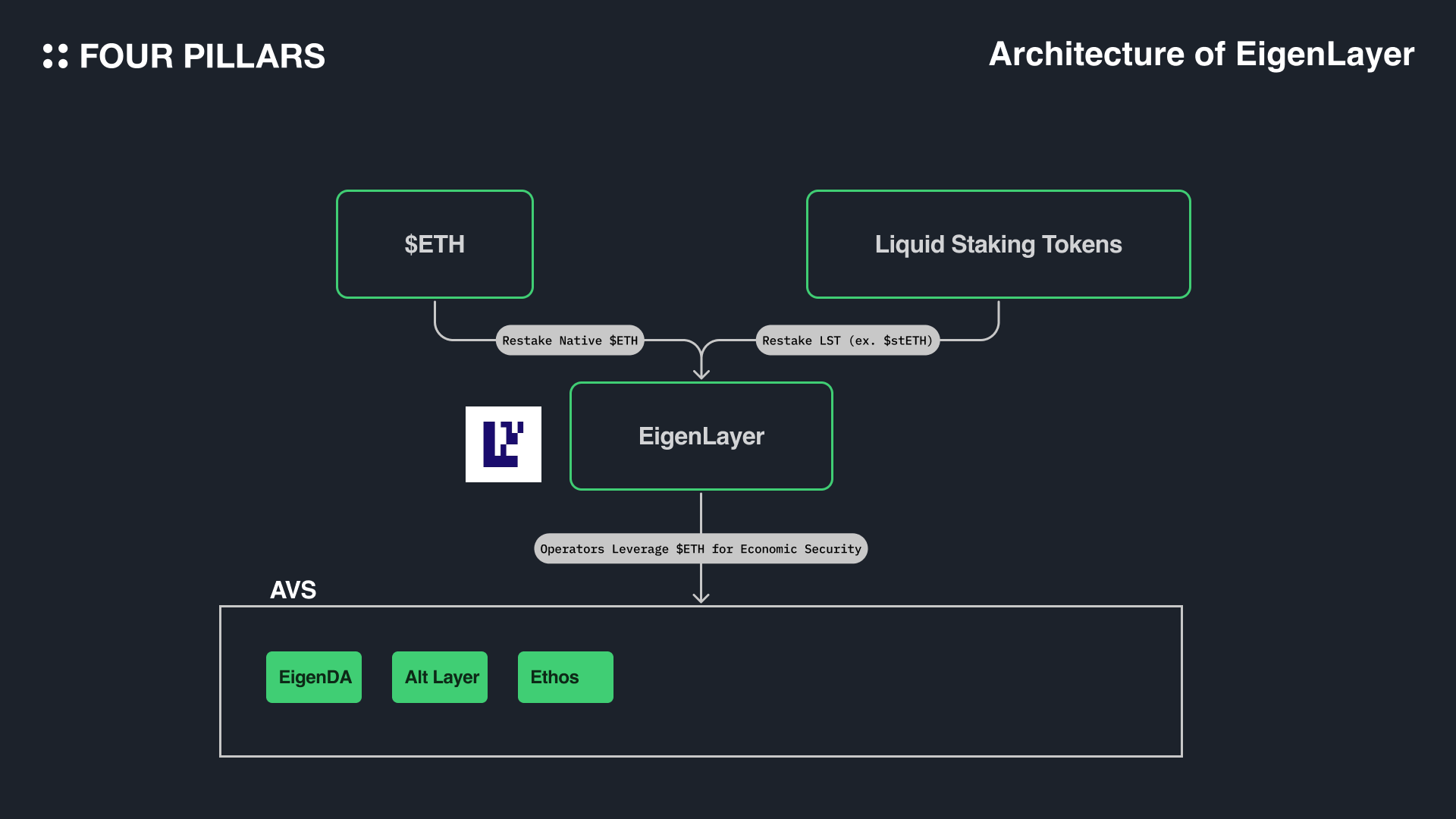
Source: The Hitchhiker's Guide to Restaking
EigenLayer is a protocol built on Ethereum that enables stakers to restake their Ethereum (either native ETH or liquid staking tokens) to provide security for additional decentralized services, known as Actively Validated Services (AVSs).
The key components and how they interact are:
Stakers: Ethereum stakers can deposit their staked ETH or liquid staking tokens (LSTs) into EigenLayer's StrategyManager contract. This allows them to restake their ETH to secure additional AVSs.
Operators: Operators are entities that run the off-chain software for specific AVSs. They register with EigenLayer's DelegationManager contract, which allows stakers to delegate their restaked ETH to the operators.
Actively Validated Services (AVSs): AVSs are the decentralized services or applications built on top of EigenLayer. They have their own on-chain contracts that interact with EigenLayer's core contracts to leverage the pooled security provided by stakers. AVSs can include things like data availability layers, bridges, oracles, and more.
A.2.2 Lifecycle of Restaking
The process works as follows:
Stakers deposit their ETH or LSTs into EigenLayer's StrategyManager contract, opting to restake their assets.
Operators register with EigenLayer's DelegationManager, allowing stakers to delegate their restaked ETH to the operators.
Stakers choose which operators they want to delegate their restaked ETH to, effectively becoming validators for the AVSs those operators are running.
The AVSs interact with EigenLayer's core contracts, such as the StrategyManager and DelegationManager, to leverage the pooled security provided by the stakers' restaked ETH.
Operators run the off-chain software for the AVSs they are supporting, contributing to the security and integrity of those services.
Stakers earn additional rewards for restaking their ETH and securing the AVSs, while the AVSs benefit from the increased security and trust provided by the pooled Ethereum staking.

Source: EigenLayer: How Restaking Will Transform Security for Ethereum-Based Protocols
This model allows for the reuse of Ethereum's staked ETH to secure a wide range of decentralized services, reducing the capital costs for both stakers and AVS developers, and increasing the overall security and trust guarantees for the Ethereum ecosystem.
A.2.3 Economics - Incentive and Slashing
The economics of EigenLayer's AVSs are centered around incentives for stakers and the risk of slashing:
Incentives for Stakers:
Stakers can earn additional rewards by restaking their Ethereum (either native ETH or liquid staking tokens) on EigenLayer to secure AVSs. This allows stakers to generate yield from their staked assets beyond just the base Ethereum staking rewards.
The more AVSs that are built on EigenLayer, the more opportunities stakers have to earn additional rewards by securing those services.
Slashing Risks:
While stakers can earn more rewards, they also face the risk of slashing if the AVSs they are securing are compromised.
EigenLayer's design allows for two types of security: pooled security and attributable security.
Pooled security is shared across multiple AVSs, meaning if one AVS is compromised, the entire pooled security can be slashed. Attributable security is specific to each AVS, so if an AVS is compromised, only the attributable security for that AVS can be slashed.
The combination of pooled and attributable security allows EigenLayer to scale economic security efficiently, but also introduces slashing risks that stakers must consider.
The core value EigenLayer is bringing is the ability to share “Ethereum’s Economic Security” with other projects. However, as Ethereum is the biggest ecosystem in crypto, cautious measures should be taken to apply slashing and incentive as too much slashing can cause risks to the overall ecosystem.
From the lessons from the economics of Neutron's Interchain Security (ICS), EigenLayer can structure its economics in terms of incentives, slashing, and governance in the following ways:
A.3.1 Incentives
Reward Distribution: Just as Neutron has a mechanism for using a portion of transaction fees to support broader ecosystem security, EigenLayer can implement a similar model where fees generated from AVS are used to reward stakers. This aligns stakers' interests with the overall health and security of the network.
Variable Incentive Structures: Depending on the risk and value of different AVS, EigenLayer could introduce variable incentive rates. More critical or higher-risk services could offer higher rewards, drawing more security to where it is most needed.
A.3.2 Slashing
Proportional Slashing: From Neutron's economic tied to Cosmos Hub, EigenLayer could consider a proportional slashing mechanism that corresponds to the severity of a fault or attack within its AVS. The severity should be measurable like for oracle service, slashing those provides wrong updates in a certain timeframe. This could be implemented with an optimistic approach, where it receives penalty at the end of timeframe, rather than instantly, to have time to take measures.
Graduated Penalties: Implement graduated penalties based on the type and frequency of infractions. This could include a warning system or minor penalties for first-time or small infractions, escalating to more severe penalties for repeated or grave offenses.
By adapting these strategies from Neutron, EigenLayer can potentially create a robust and sustainable economic model that incentivizes participation and ensures network security.
A.3.3 Governance
Decentralized Governance: Like Neutron, EigenLayer can enhance decentralized governance for each AVS by allowing related token holders to participate directly in decision-making processes without needing to delegate their stakes. This could help increase engagement and distribution of power within the community.
Dynamic Participation: Implement a governance mechanism that allows stakers to vote on key issues such as incentive adjustments, fee structures, and slashing parameters. This empowers users to respond to changing conditions and needs within the ecosystem dynamically.
Thanks to Kate for designing the graphics for this article.
We produce in-depth blockchain research articles

In the era of AGI, what will we consider valuable? Likely, content that is certified as "human-made" will stand out as valuable. In other words, the focus of value evaluation will shift from the quality of the content to who created it. Therefore, our next challenge is identifying what is human and what is not in the digital world. Let me introduce the Humanity Protocol, which is utilizing Proof of Humanity (PoH) to create the infrastructure needed to prove our humanity and distinguish between humans and AI in the era of AGI.

Starting with a social wallet using Web2 social logins, Particle Network now focuses on simplifying multi-chain complexities with their core product, Universal Account Stack (Universal Account, Liquidity, and Gas). In this article, let’s look into the core components when crypto users interact with and what exactly Particle Network is building to provide the “Future of Crypto UX.”

This is a piece explaining the problems defined by the KYVE Network and the unique structure of the KYVE Network.

In the trading phase of crypto adoption, where most crypto assets are concentrated, exchanges need an infrastructure that is both highly reliable and does not compromise the trading experience. A hybrid exchange design approach, like that of Cube.Exchange, can be suitable in this regard.